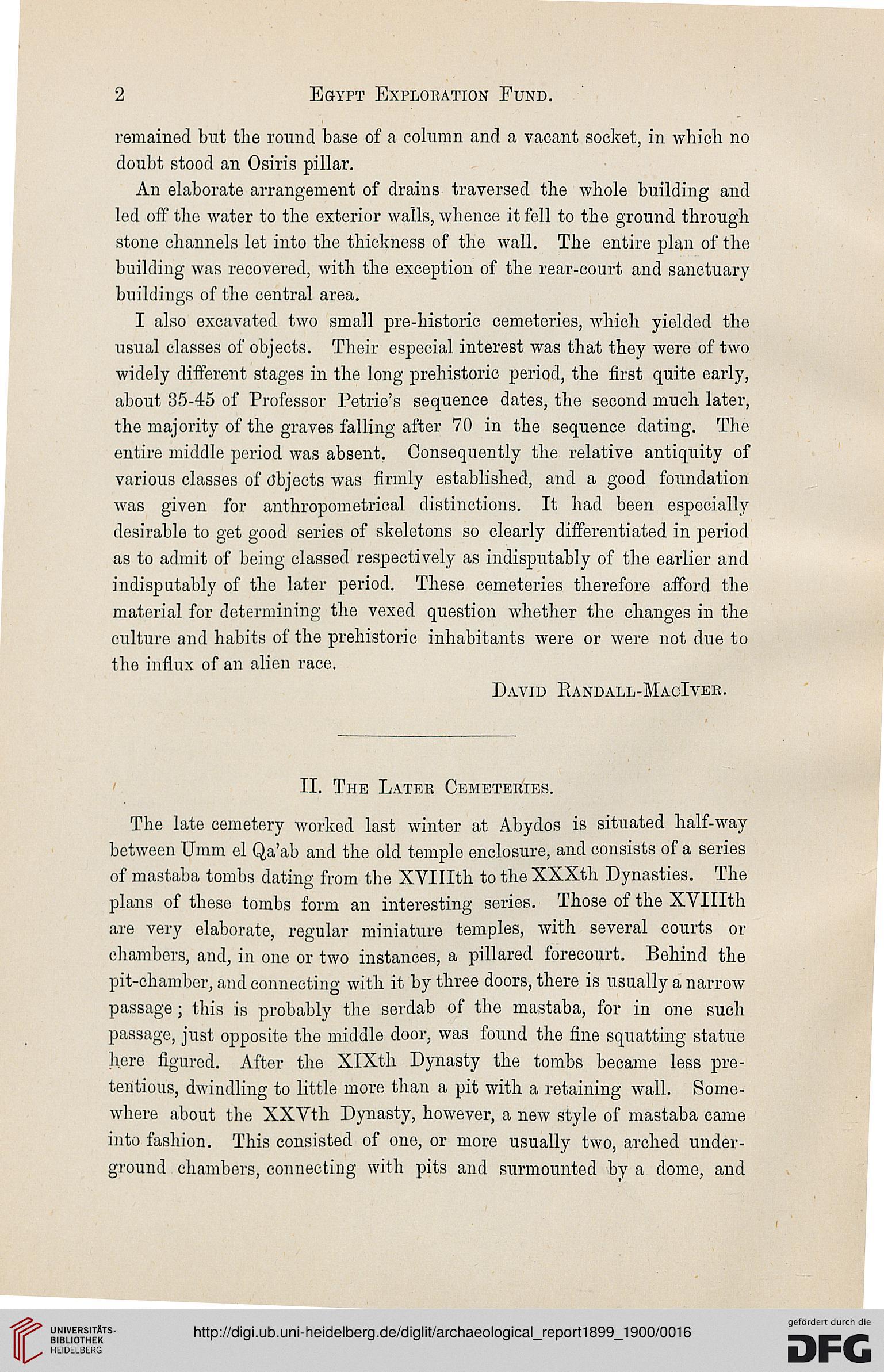2
Egypt Exploration Fund.
remained but the round base of a column and a vacant socket, in which no
doubt stood an Osiris pillar-.
An elaborate arrangement of drains traversed the whole building and
led off the water to the exterior walls, whence it fell to the ground through
stone channels let into the thickness of the wall. The entire plan of the
building was recovered, with the exception of the rear-court and sanctuary
buildings of the central area.
I also excavated two small pre-historic cemeteries, which yielded the
usual classes of objects. Their especial interest was that they were of two
widely different stages in the long prehistoric period, the first quite early,
about 35-45 of Professor Petrie's sequence dates, the second much later,
the majority of the graves falling after 70 in the sequence dating. The
entire middle period was absent. Consequently the relative antiquity of
various classes of dbjects was firmly established, and a good foundation
was given for anthropometrical distinctions. It had been especially
desirable to get good series of skeletons so clearly differentiated in period
as to admit of being classed respectively as indisputably of the earlier and
indisputably of the later period. These cemeteries therefore afford the
material for determining the vexed question whether the changes in the
culture and habits of the prehistoric inhabitants were or were not due to
the influx of an alien race.
David Randall-MacIver.
II. The Later Cemeteries.
The late cemetery worked last winter at Abydos is situated half-way
between Umm el Qa'ab and the old temple enclosure, and consists of a series
of mastaba tombs dating from the XVIIIth to the XXXth Dynasties. The
plans of these tombs form an interesting series. Those of the XVIIltli
are very elaborate, regular miniature temples, with several courts or
chambers, and, in one or two instances, a pillared forecourt. Behind the
pit-chamber, and connecting with it by three doors, there is usually a narrow
passage ; this is probably the serdab of the mastaba, for in one such
passage, just opposite the middle door, was found the fine squatting statue
here figured. After the XlXth Dynasty the tombs became less pre-
tentious, dwindling to little more than a pit with a retaining wall. Some-
where about the XXVth Dynasty, however, a new style of mastaba came
into fashion. This consisted of one, or more usually two, arched under-
ground chambers, connecting with pits and surmounted by a dome, and
Egypt Exploration Fund.
remained but the round base of a column and a vacant socket, in which no
doubt stood an Osiris pillar-.
An elaborate arrangement of drains traversed the whole building and
led off the water to the exterior walls, whence it fell to the ground through
stone channels let into the thickness of the wall. The entire plan of the
building was recovered, with the exception of the rear-court and sanctuary
buildings of the central area.
I also excavated two small pre-historic cemeteries, which yielded the
usual classes of objects. Their especial interest was that they were of two
widely different stages in the long prehistoric period, the first quite early,
about 35-45 of Professor Petrie's sequence dates, the second much later,
the majority of the graves falling after 70 in the sequence dating. The
entire middle period was absent. Consequently the relative antiquity of
various classes of dbjects was firmly established, and a good foundation
was given for anthropometrical distinctions. It had been especially
desirable to get good series of skeletons so clearly differentiated in period
as to admit of being classed respectively as indisputably of the earlier and
indisputably of the later period. These cemeteries therefore afford the
material for determining the vexed question whether the changes in the
culture and habits of the prehistoric inhabitants were or were not due to
the influx of an alien race.
David Randall-MacIver.
II. The Later Cemeteries.
The late cemetery worked last winter at Abydos is situated half-way
between Umm el Qa'ab and the old temple enclosure, and consists of a series
of mastaba tombs dating from the XVIIIth to the XXXth Dynasties. The
plans of these tombs form an interesting series. Those of the XVIIltli
are very elaborate, regular miniature temples, with several courts or
chambers, and, in one or two instances, a pillared forecourt. Behind the
pit-chamber, and connecting with it by three doors, there is usually a narrow
passage ; this is probably the serdab of the mastaba, for in one such
passage, just opposite the middle door, was found the fine squatting statue
here figured. After the XlXth Dynasty the tombs became less pre-
tentious, dwindling to little more than a pit with a retaining wall. Some-
where about the XXVth Dynasty, however, a new style of mastaba came
into fashion. This consisted of one, or more usually two, arched under-
ground chambers, connecting with pits and surmounted by a dome, and





